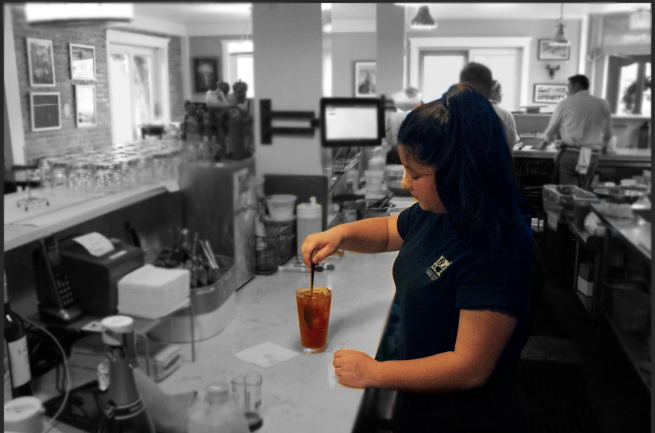Eleven million eight hundred forty-six thousand.
This is the amount of unemployed youth, ages 16-19, in the United States according to 2017 Kids Count Data Center.
This number also reflects that there was a 1 percent drop in the employment rate of youth compared to the previous year.
Teens are finding it difficult to get a job. As a matter of fact, most teens don’t work. The employment rate for high school students is only 20 percent, according to a study in October 2017 by Child Trends.
Many high school students find that they are less able to compete for available positions, solely based on their age and experience. Those jobs are taken by either college students or adults who are older and are more likely to have worked before.
In a study conducted by Pew Research Center, it was revealed that when high school students do find work, it tends to be in “accommodation and food service” like Starbucks or Jamba Juice where lots of employees are needed for the multiple shifts throughout the day. These jobs tend to be entry-level positions that have fewer skill requirements, so teens are able to find work in this area.
Emma Weitz, a sophomore, was able to find her job at Farm House Restaurant through her friend.
“My friend’s family owns the restaurant, and I was able to use that connection to get a job,” Weitz said.
Locating an open job that the student is qualified for is the first obstacle faced by teens. The second challenge is finding a job that will accommodate to a student’s school life.
For Simon Tara, a senior at Carlmont, balancing his school schedule with his work schedule has taken some adjustment.
“It’s a lot of time management. Working around schedules and making sure you do things right and on time, not just for school and football, but at work too, is really important,” Tara said.
After finding a job that can balance with school and outside commitments like sports or extracurriculars, students then proceed to apply for those jobs. This usually requires a student to create a resume, which is a document that showcases the student’s work and life experiences.
At Carlmont High School, some of the AVID classes have students create resumes in class. This gives students the opportunity for them to be reviewed before distributing them to employers.
“It was hard putting it together because you want to put enough information about yourself, yet you don’t want too much information that will overwhelm the employer,” Tara said.
After turning in resumes and applications, students typically have to interview for jobs.
This can be a stressful process for many, even if their resumes are filled to the brim with experience.
“I think it helps to practice a little beforehand by anticipating possible questions. A good idea would be for a student to role-play with a teacher or counselor. I have done this for students who are nervous about an upcoming interview, and it seems to help,” Theresa Torres, a guidance counselor at Carlmont, said.
Once the interview process is complete and they have been hired, students have to fill out a work permit.
Carlmont math teacher John Rowe is in charge of processing work permits for students this year. So far, he has processed 138 permits for students, which equals only about 6 percent of the total students at Carlmont. In 2017, the national average of students who were working while also enrolled in high school was 19.5 percent.
Rowe said that the process for filling out work permits isn’t that hard.
Once processed, which, according to Rowe, only takes 24 hours, the student can give it back to their employer and begin working.
All of the multiple steps that are required in order to get a job are various reasons so few high schoolers have them.
“I think (students not working) is a case by case topic. All students are different and have different lives and responsibilities. If students can stay organized then jobs are great because it teaches them skills like leadership and responsibility,” Torres said. “But if they have a heavy load it might not be right for them.”
Other than the difficulty in finding and successfully obtaining a job, Pew Research Center also reveals that the average of working teens ages 16-19 dropped about 20 percent from 2007 to 2009 during the Great Recession.
Pew researchers concluded multiple components to why fewer young people are working. Some of these include later endings and earlier beginnings to school, more students enrolled in school over summer, and more students doing community service work for graduation requirements or their college applications.
The Atlantic also provides an explanation as to why many teens no longer have jobs, both during summer and the school year.
They found that “teenagers aren’t spending more time on the couch, but rather spending more time in the classroom. Education is to blame, rather than indolence.”
This represents that many teens and students don’t work because they are doing school work, no matter the season.
The low employment rate is not reflective of what teens actually want in regards to working. Teens want to work for various reasons.
“I work to help with bills around the house, and it also teaches me responsibility. I know that the experience I’m getting will be beneficial in the long run,” Tara said.
Morgan Psalia, a senior at Carlmont, agrees with Tara, in that having a job as a teen is great for experience.
“I have a job to earn money plus I really enjoy working. I love communicating with customers and working as a team with my workmates,” Psaila said.
Other teens, however, just choose not to work, or have too many commitments that make them unable to have a job.
Two sophomores at Carlmont, Sophia Campbell and Jacey Kelly, don’t have jobs for their own reasons, with an added age factor.
“I don’t have a job because I can’t drive yet and my parents are very busy so they can’t drive me. Also, I have a lot of homework that takes up a lot of my time,” Campbell said.
Kelly is very involved with her school. She is part of ASB and is on the Carlmont swim team, which fill her hours outside of school all year round.
“I just haven’t really gotten around to it, and a lot of jobs have an age requirement of 16 so I can’t apply for them,” Kelly said.
Despite the reports of overall drops in teen employment, more recent data reports that between the months of April to July in 2018, there has been a 55 percent increase in youth employment.
“During these months, large numbers of high school and college students search for or take summer jobs,” the Bureau of Labor Statistics said.
This gives hope to all the teens searching for jobs whether they be in the summer or all year round. Employment is attainable, and there are some positive signs of job availability, although it is definitely something most people have to put a large amount of effort into.
“Let as many people as possible know that you are looking. You never know when someone will know someone, who knows someone who has a friend who is hiring! Send out multiple resumes, and applications, and don’t get discouraged if you get turned down for some. Keep trying — sometimes it takes a while,” Torres said.






















